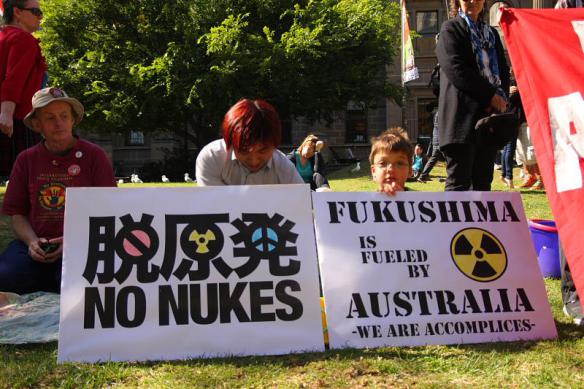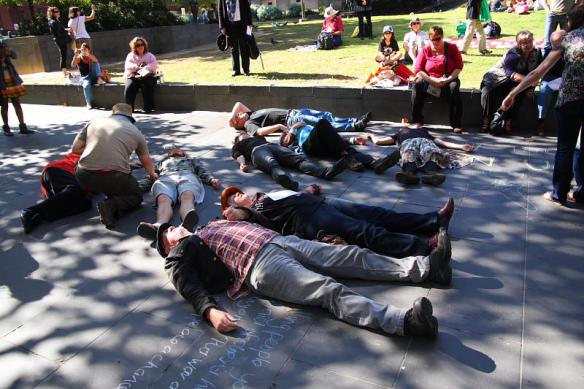
ICAN (The International Campaign to Abolish Nuclear Weapons) along with Japanese for Peace and MAPW (Medical Association for Prevention of War) organised a candlelight vigil outside the old GPO in Melbourne ‘to honour the victims of this terrible tragedy, and to show our concern for the safety of those who have been exposed to radioactivity from the Fukushima nuclear power plant’.
It was not originally intended to have formal speakers, but in the event there were several addresses: a member of JFP read letter from another member resident in Kew, Melbourne, whose home town in Japan had been destroyed by the tsunami. She had been trying to get news of relatives there, and although eventually successful in determining that they were alright, was herself still too distressed to attend the vigil. Instead, she had sent the letter [text to follow when available]. Other speakers were representatives of MAPW – the Medical Association for the Prevention of War – the Railways Union, Friends of the Earth, and ICAN, whose Campaign Director Tim Wright was MC.
There is a report by Takver on Melbourne Indymedia, and more photos on Takver’s Flickr Photostream (http://www.flickr.com/photos/takver/sets/72157626160141551/)

Reading the letter

Origami cranes and candles

MAPW speaker: The bottom line is, the take-home message is, there is no safe level of radiation …
See also MAPW media release

Jim Green, FoE spokesperson on nuclear matters, summarised the situation as far as that was possible on the sometimes contradictory information being released. He mentioned various plausible scenarios, ranging from the best, that the situation could be brought under control, with minimum human exposure to radiation following the mass evacuations, all the way to the nightmare of self-sustaining chain reactions … “We don’t know how this is going to play out, but either way it’s a disaster…” He suggested however that it was not too early to start drawing lessons for the future: “TEPCO is a company with a track record of accidents, of falsifying safety data and of mishandling earthquake situations …” Amongst other things, in 1984 the company had had to implement an emergency shutdown at one of its reactors and had kept it secret for 25 years… Finally, he raised the matter of Australia’s culpability in this matter, it having been well aware of TEPCO’s record ‘and the unwillingness of the Japanese government to hold these utilities to account … but [having] been perfectly willing to allow uranium sales to proceed from Australia to Japan…’. He named BHP Billiton and Rio Tinto as also culpable, and ended by urging everyone to get involved in the quest to make the world free of nuclear weapons and nuclear power. See also FoE media release Spinning Fukushima.

The issue of Australia’s responsibility was echoed by another speaker from Japanese for Peace, Tomohiro Matsuoka: Australia was related to this disaster, because Australia and Canada were the two largest suppliers of uranium to the Tokyo Electric Power Company ‘so this radioactive material spreading from Fukushima actually originates from Australia. So we must stop this export of uranium to overseas … if you are serious about this disaster.’
Another speaker was Victor Moore of the Rail, Tram and Bus Union, pledging solidarity with workers affected by the disasters: ‘this is a very sombre occasion, and ourhearts go out to [those] directly affected. This is going to be a very long, sustained campaign in terms of rebuilding Japan, in terms of ensuring that those who don’t have wealth in Japan are looked after, those that are homeless, those that are poor, those that aren’t part of the rich are looked after in Japan, and unfortunately at the moment those are the ones who are most greatly affected …’

More images:

























